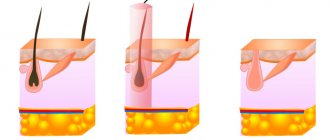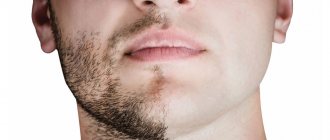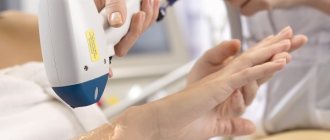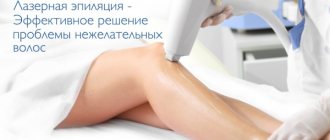In the modern world, there are many ways to deal with unwanted hair, and if you know about laser hair removal, then you have probably heard about photoepilation, the results of which are liked by many more than after using any other methods.
Let’s find out together whether this procedure is reliable and what to expect from it.
Why do they grow?
An ingrown hair is a hair that cannot penetrate the structure of the skin and begins to grow in the opposite direction or curl in the skin in the form of a spiral.
It is quite easy to recognize ingrown hairs after hair removal, especially immediately after the procedure, since that is when they are very noticeable on smooth skin.
The ingrowth area may look like local redness, the appearance of a small bump on the skin, or a dark dot located under the epidermis layer. Sometimes the hair is visible in full length or twisted in a “ring”, but it is hidden under a layer of skin, which is why it cannot be removed using regular depilation.
To understand why hair grows after hair removal, you should study all the possible causes of this side effect:
- Hard hair structure.
- Skin too thick.
- Illiterate performance of depilation. Ingrowth occurs due to damage to the hair follicle when it is pulled out incorrectly.
- Regular use of machines and epilators to remove unwanted hair.
- Ignoring recommendations for skin care after the procedure.
From the cause of the appearance of ingrown hairs, you can understand how to deal with ingrown hairs after hair removal and prevent their occurrence in the future.
Sometimes ingrown hairs appear after hair removal due to the girl’s hormonal characteristics. Then it will not be possible to radically correct the problem.
Bikini photoepilation: before and after - photo gallery
The essence of photoepilation technology is to treat the problem area with broadband pulsed light (abbreviated IPL). The development belongs to Israel, then, under other names, it was adopted and began to be used in other countries. Researchers suggested using UV radiation. In itself, it is harmful to the body, so the device was equipped with a protective filter.
For convenience, a fairly wide screen was made in the device attachment (now its area ranges from 2 to 5 cm2). So in one flash it was possible to process several square centimeters of skin and about a dozen or more hairs at once.
When the problem area is illuminated, melanin, the structure-forming substance of the hair, absorbs the light wave. Then a thermal reaction starts: light is converted into thermal energy. First, the hair shaft heats up greatly, and then the heat is transferred to the hair root. Moreover, the temperature is so high - 70-80o that the follicle gets burned. After one such irradiation, the bulb atrophies for some time, and hair in this place stops growing until it is restored.
The pulsed light of the photoepilator is harmless to the skin; it acts only on cells containing melanin
Photoepilation is contraindicated for patients under 18 years of age, pregnant and lactating women and people with health problems: oncology;
- diabetes;
- heart and vascular diseases;
- skin damage in the bikini area (wounds, abrasions, bruises);
- exacerbation of inflammatory and infectious diseases;
- piercings and tattoos in the bikini area.
It is forbidden to carry out the procedure if you are allergic to sunlight.
If you know that you are allergic to sunlight, refuse photoepilation - it is the same UV radiation, only protected by a filter
Photoepilation removes dark hair well, but modern devices can also handle light hair. To carry out the procedure, the length of hair in the bikini area must be at least 2 mm. The photoepilator can process deep bikinis, the main thing is not to touch the mucous membrane
Why are ingrown hairs dangerous?
Ingrown hairs themselves are not so dangerous, since visually they are simply imprisoned in the structure of the epidermis and cannot break out. The consequences that can result from prolonged ingrown hairs and neglect of treatment can be dangerous.
There are two types of ingrown hairs:
- Superficial. It is quite simple to extract such hairs; they are located in the upper layers of the epithelium. They usually look like an ordinary hair growing under a thin layer of the epidermis, and at first glance it is impossible to understand that it is ingrown.
- Internal. They lie in the deeper layers of the epidermis, and visually they usually look like hairs twisted into a ring.
If a superficial ingrown hair can spontaneously break through a thin layer of skin over time, then serious problems can arise with the internal one.
Leaving the hair in this state for a long time can lead to serious inflammatory processes, which are accompanied by pain and swelling. Then you will have to contact a surgeon to open them. However, even with careful removal of the ingrowth, a small scar may remain on sensitive skin.
Bikini photoepilation: before and after - photo gallery
There are some contraindications to photoepilation. The consequences of harmless hair removal methods, if this information is not taken into account, can be very serious.
These include:
- local foci of inflammation, non-healing wounds in the area of hair treatment;
- tattoo is a relative contraindication;
- taking medications (steroids, hormonal, cytostatic, antibacterial agents);
- pacemaker, insulin pump (or other medical electronic devices);
- allergic reactions (peeling) during prolonged exposure to the sun;
- blood diseases (porphyria);
- oncological diseases;
- during pregnancy or lactation.
How to get rid of it?
You need to take measures to remove unwanted ingrowth immediately after you notice it. This way you will prevent the occurrence of negative consequences when ignoring the defeat.
There are other ways to eliminate ingrowth yourself:
- Steam the affected area thoroughly with hot water and then use an abrasive scrub. It will help remove dead epithelial cells from the epidermis and allow the hair to come out on its own.
- In the early stages of ingrowth, you can use acne cream. It also eliminates inflammation and helps restore normal hair growth.
- Removal with a needle or tweezers. The skin must first be steamed, the instrument must be treated with a disinfectant solution, and then the ingrown hair must be carefully lifted, pulling it out along with the hair bulb.
Be careful - if you cannot eliminate the ingrowth on your own, it is better to abandon this idea so as not to aggravate the situation. Contact a surgeon to carefully restore the integrity and health of the skin.
Operating principle
So, how long does it take for hair to fall out after laser hair removal? To understand this issue, you need to understand a little about the mechanics of this process.
The laser beam, penetrating through light skin, affects pigmented areas - in this case, hair follicles, and destroys the dark pigment in them. You may notice hair loss within a few days: due to the destruction of the hair follicles, those hairs that were in the active growth stage at the time of the procedure begin to fall out - that is, they were slightly visible through the skin. You can find out about bikini sugaring at home here.
After the first procedure, noticeable hair loss will begin after 7-10 days. This is the time during which the hairs from the destroyed follicles are rejected by the skin and come out. In their place, new ones may begin to grow, but softer and lighter. Subsequent procedures will relieve you of them too.
What should I do to prevent them from growing in?
You can prevent such a side effect as ingrowth before performing the procedure, and this can be done quite simply if you follow some aftercare recommendations.
Recommendations are prescribed both for preparing for depilation and for skin care after it:
- Before depilation, use a scrub to remove the dead skin layer, providing access to the hairs;
- Immediately before and after the procedure, treat the skin and all instruments used with a disinfectant solution of Chlorhexidine;
- After manipulation, apply a soothing lotion;
- After removing unwanted hair, use special anti-ingrowing creams that further slow down hair growth.
Also, after depilation, it is recommended to avoid visiting the bathhouse, sauna and swimming pool for two days.
Side effects of photoepilation
Of course, like any cosmetic procedure, ipl hair removal has some side effects, but they are not so critical.
- Hypopigmentation, the appearance of a burn on tanned skin.
- Hyperpigmentation due to medications (hormonal, cytostatic, antibacterial agents).
- Scars, burns due to poor quality work of a specialist.
- Ingrown hairs in the epilation area.
- Oncological skin diseases are extremely rare consequences.
- Eye damage and decreased visual acuity occur when performing procedures without protective glasses.
However, the risk of these negative manifestations when working with a professional cosmetologist with experience in the field of ipl hair removal is practically reduced to zero. Naturally, if the client followed all the rules for preparing areas of the body for visiting the salon and hair removal and took into account contraindications.
How to epilate?
If you use an epilator to remove unwanted hair from your body, it is important to follow the rules for its use. Do not press too hard and operate it as smoothly as possible, without sudden movements. If you notice that the epilator does not pull out hairs, but cuts them off, you should replace the attachment.
If you use waxing or sugaring as a method for hair removal, you should apply the working paste exclusively in the direction of hair growth, and pluck it in the opposite direction. This is the only way you can prevent ingrown hairs after the procedure.
It is recommended to change procedures periodically. Don't do this too often - one shift every 6-8 months is enough.
Photoepilation price by zone?
Price for one procedure depending on zones:
- Eyebrows – $67.
- Photoepilation of the upper lip – $60–70.
- Forehead – $60.
- Cheeks – $60.
- Whole face – $80.
- Belly – $60–70.
- Chin – $60.
- Breast area – $50.
- Armpits – $70.
- Bikini – $80.
- Photoepilation of the intimate area – $160.
- Shins – $180.
- Hips – $200.
- Legs – $350.
- Back – $60–70.
- Neck – $70.
- Buttocks – $90.
How to shave?
You also need to be careful with the razor. Despite the fact that most girls use it, many still do not know how to use it correctly.
Firstly, the recommendation for moving the razor is the same as when using other methods of depilation - you need to move it strictly according to hair growth. If you choose a sharp razor with the right attachment, it will completely cut off hair, leaving you with perfectly smooth skin.
Secondly, before the procedure you should apply shaving foam or lotion. Good gliding of the razor over the skin will reduce the risk of cuts and also increase the efficiency of manipulation.
It is better to buy reusable razors that have the ability to change heads. Disposable razors are always stiffer and more uncomfortable, which is why the risk of ingrown hairs when using them is higher.
Compatibility of solarium and hair removal
You cannot combine hair removal with solarium. During each procedure, the skin is injured and the risk of side effects increases. For example, age spots, burns and pimples may appear if you visit a solarium immediately after hair removal. It takes several days for the skin cells to recover and adapt to the environment. Moisturizers designed for sensitive skin will help speed up the recovery process.
Also interesting: Rules for tanning in a solarium for men, contraindications, benefits and harms
The best means
After each depilation, it is recommended to use special compounds to slow down hair growth and prevent ingrown hairs.
Let's consider popular lines that are often recommended by cosmetologists:
- DEPILFLAX;
- ARAVIA PROFESSIONAL;
- SAONA COSMETICS;
- CRISTALINE;
- Veet.
They need to be applied an hour after the procedure, as well as the next day after it. This way you will protect yourself from ingrowth.
Answers to frequently asked questions
How many photoepilation procedures do you need to undergo? To achieve the desired results, you need to complete a full course of 3 to 6 procedures every one and a half months. One of the effects of this type of hair removal is a slowdown in hair growth, so the interval between sessions will increase. The less body hair remains, the longer the interval between sessions will be.
Is it possible to sunbathe after photoepilation? You can sunbathe after photoepilation only after a week, but you must use sunscreen.
Folk remedies against ingrown hairs
You can eliminate ingrown hairs yourself, but this should only be done when superficial ingrown hairs form.
To soothe the skin and relieve inflammation, it is recommended to make herbal lotions. To do this, you need to pour boiling water over any pharmaceutical herb for 30-40 minutes, then strain it and moisten the gauze. Gauze is applied as a compress to the affected area for 20 minutes twice a day.
You can also make a natural scrub; there are many similar recipes:
- Scrub with salt. Mix olive oil, sea salt (coarsely ground) and moisturizer in equal proportions. After treating the skin with such a scrub, it is recommended to wipe it with a mixture of salicylic acid and calendula tincture. This will help reduce inflammation.
- Scrub with bodyaga. Bodyagi powder is mixed in equal parts with hydrogen peroxide and applied to the girl’s skin.
- Sugar scrub . Mix 2 parts cane sugar, 1 part olive oil and a little tea tree oil for a soothing effect.
Any scrub should be used only on a previously steamed body; this will increase the effectiveness of manipulations and speed up the removal of ingrown hairs.
Possible consequences
Experts, when asked whether it is possible to go to a solarium after hair removal, answer that in this case it is better to wait with tanning. Regardless of the method of removing unwanted hair, the skin requires careful care and protection from ultraviolet radiation. Her sensitivity is too heightened. UV rays have negative side effects after laser, photo and electrolysis:
- varying degrees of burns;
- hyperpigmentation;
- tan in spots and different shades;
- mechanical damage to the dermis;
- allergic reactions, itching, burning and hyperemia of the skin.
If you sunbathe in a solarium immediately after depilation with wax, sugar paste, or an epilator, black spots may form on your body. It will be extremely difficult to get rid of them. The likelihood of ingrown hairs also increases.
Sugaring and waxing
During sugaring, a special sugar paste is used, and during waxing, hot wax is used to remove hair. Both sugar and wax stick to the hair, removing it from the root. This causes injury to the skin, so it is not recommended to sunbathe after sugaring.
Several days must pass after hair removal for the skin to recover. In addition, hair removal should not be performed after solarium. Along with the hair, the top layer of the epidermis can be removed, which will lead to uneven tanning or skin burns.
Useful tips
In order to get the maximum effect from hair removal, you should follow these simple tips:
- The minimum hair length should be half a centimeter for quick and painless hair removal.
- It is not recommended to visit the sauna or swimming pool before the procedure.
- Before and after the procedure, solarium is contraindicated.
- After hair removal, moisturizers should be applied to the skin to quickly restore the damaged upper layer of the epidermis.
- All instruments for hair removal must be sterile to minimize the risk of infection.











